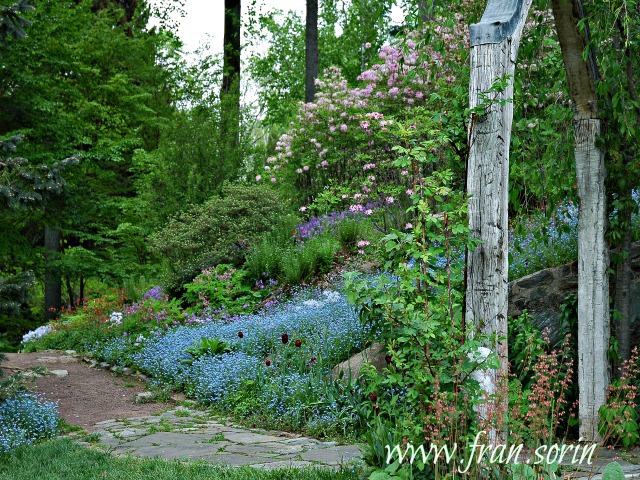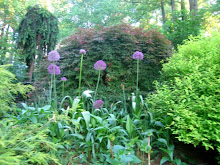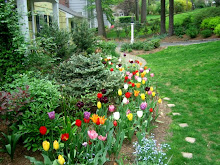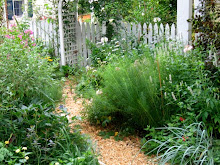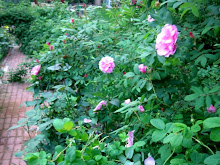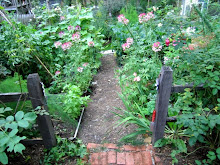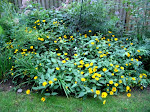Welcome to Heirloom Gardener
Sunday, September 13, 2009
Saturday, August 08, 2009
Thursday, August 06, 2009
Tuesday, August 04, 2009
Double Tiger Lily from Old House Gardens in the Walled Garden
Posted by
Julia Erickson
at
6:00 PM
6
comments
![]()
![]()
Labels: Lilies
Friday, July 24, 2009
White Elegance Lilies next to the Stone Staircase
Posted by
Julia Erickson
at
6:00 PM
6
comments
![]()
![]()
Labels: Lilies
Wednesday, July 08, 2009
African Queen Lily (1958) in the Rose and Egg Gardens


Posted by
Julia Erickson
at
9:11 PM
7
comments
![]()
![]()
Labels: Lilies
Sunday, July 05, 2009
Regal Lily (1905) in the Hydrangea Border
Posted by
Julia Erickson
at
6:00 PM
1 comments
![]()
![]()
Labels: Lilies
Tuesday, October 21, 2008
Autumn Beauty: Metamorphosis of the Blackberry Lily from Blooms to Seedheads
As a follow-up to last year's post on the Blackberry Lily (Belamcanda chinensis), I made sure to capture the delicate flowers this year in addition to the attractive seedpods and seedheads: "The blackberry lily blooms at the end of July over several weeks. The flowers and seed heads make great cut flowers for arrangements. These lovely seedheads develop in autumn." The first picture shows a close-up of the bloom.
"The blackberry lily blooms at the end of July over several weeks. The flowers and seed heads make great cut flowers for arrangements. These lovely seedheads develop in autumn." The first picture shows a close-up of the bloom. The second picture shows the plant in between the blooms and the immature green seedpods.
The second picture shows the plant in between the blooms and the immature green seedpods.
The third picture shows the plant shedding the now brown and papery seedpods to reveal the black seedheads from which they derive their name.
"Resist temptation: do not eat them. The seedheads persist into winter. They will drop and produce more plants the following spring. Although it does self seed, it is not prolific and gives a more natural look to the garden. The seedling take one to two years to reach blooming size. Note: they are deer resistant."
Posted by
Julia Erickson
at
9:49 PM
1 comments
![]()
![]()
Labels: Autumn Garden, Lilies, Seed Heads, Self Seeders
Tuesday, September 02, 2008
Heirloom Lilies for Fall Planting
As a follow-up to my prior post about some of my favorite lilies this year, Anne Raver at The New York Times also had some heirloom suggestions for fall planting. Like me, she highlighted Excelsior as one of her favorites:
"Up in my own garden, a few heirloom lilies have thrived on plenty of compost, sun and the protection offered by stone walls: Black Beauty, a tall hybrid Turk’s-cap with dark raspberry flowers; Citronella, a shorter lemon-yellow, freckled Turk’s-cap; Excelsior, a fragrant white trumpet speckled with red; and White Henryi, a trumpet lily with swept-back ivory petals and an apricot throat. But the voles and mice have eaten a lot of the bulbs — rodents love lilies as much as tulips — so it’s time to order more for fall planting."
Posted by
Julia Erickson
at
10:10 PM
1 comments
![]()
![]()
Labels: Lilies
Friday, August 08, 2008
Two New Summer Favorites: Double Tiger Lily and Excelsior Lily
My two favorite new lilies this year were the double tiger lily and the Excelsior lily both from Old House Gardens.
 The double tiger lily bloomed over a four week period in part shade. The flowers are definitely interesting and far more attractive than the catalog picture is able to capture.
The double tiger lily bloomed over a four week period in part shade. The flowers are definitely interesting and far more attractive than the catalog picture is able to capture. Since tiger lilies rapidly reproduce from the small bulblets that form along the stem, I am hoping that they will take over the open space next to the fort in the Walled Garden.
Since tiger lilies rapidly reproduce from the small bulblets that form along the stem, I am hoping that they will take over the open space next to the fort in the Walled Garden. For fragrance, the Excelsior lily is phenomenal. The fragrance is rich and unlike any of the other lilies I grow. In addition, they came at a time when my other lilies were finished except for yet to bloom Rubrum Lily.
For fragrance, the Excelsior lily is phenomenal. The fragrance is rich and unlike any of the other lilies I grow. In addition, they came at a time when my other lilies were finished except for yet to bloom Rubrum Lily. The colors are a beautiful and vibrant mix of yellow, cream, and peach. I will be ordering more of these for my cutting garden next year.
The colors are a beautiful and vibrant mix of yellow, cream, and peach. I will be ordering more of these for my cutting garden next year.
Posted by
Julia Erickson
at
9:34 PM
4
comments
![]()
![]()
Labels: Lilies, Summer Garden
Sunday, December 02, 2007
Blackberry Lily Seedheads
 I love splashes of orange in the garden. My blackberry lily has small orange flowers with red dots. There is another cultivar that is yellow. They do not look like lilies. Unfortunately, I don't think I took a picture of the flowers. I have to remember to take some pictures of them next year.
I love splashes of orange in the garden. My blackberry lily has small orange flowers with red dots. There is another cultivar that is yellow. They do not look like lilies. Unfortunately, I don't think I took a picture of the flowers. I have to remember to take some pictures of them next year.
The blackberry lily blooms at the end of July over several weeks. The flowers and seed heads make great cut flowers for arrangements.
These lovely seedheads develop in autumn. The first picture shows the immature pods. The outside becomes brown and papery. They break open to reveal the luscious blackberry seedheads. Resist temptation: do not eat them. The seedheads persist into winter. They will drop and produce more plants the following spring.
Although it does self seed, it is not prolific and gives a more natural look to the garden. The seedling take one to two years to reach blooming size. Note: they are deer resistant.
Note: they are deer resistant.
Posted by
Julia Erickson
at
11:53 PM
0
comments
![]()
![]()
Labels: Autumn Garden, Lilies, Seed Heads, Self Seeders, Winter Garden
Search Heirloom Gardener
Labels
- About Blogging
- Annuals/Biennials and Perennials
- Autumn Garden
- Books and Movies
- Botanical Gardens
- Bulbs and Tubers
- Children's Garden
- Chrysanthemum
- Clematis
- Container Gardening
- Crocus tommasiniasus roseus
- Cut and Forced Flowers
- Cutting and Rose Gardens
- Dahlias
- Deep Thoughts About Gardening
- Egg Garden
- Fences Arbors Walls and Paths
- Floral arrangements
- Front Border
- Fun Stories About Gardening
- Garden Bloggers' Bloom Day
- Garden Bloggers' Design Workshop
- Garden Planning
- Gardening Blogs
- Gardening Tools and Structures
- Gardening with Children
- Goldberry Hill
- Heirloom and Organic Food
- Hibiscus
- Holidays
- Hydrangeas
- Japanese Beautyberry
- Lilies
- Mixed Borders
- New Jersey / Local Interest
- Nurseries
- Online Gardening Resources
- Peonies
- Pest Control
- Picture This Photo Contest
- Piet Oudolf
- Poppies
- Propagation and Seeds
- Pruning and Maintenance
- Roses
- Seed Heads
- Self Seeders
- Shrubs
- Spring Garden
- Summer Garden
- Trees
- Wildlife in the Garden
- Winter Garden
- Zinia













